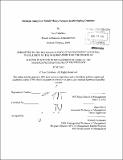Strategic analysis of mobile money ventures in Developing countries
Author(s)
Caballero, Luis (Luis Alberto Caballero Parra)
DownloadFull printable version (7.460Mb)
Other Contributors
Sloan School of Management.
Advisor
Jason Davis.
Terms of use
Metadata
Show full item recordAbstract
Mobile money services are spreading rapidly in many developed and developing countries across the world. Whereas in developed economies these new services are seen as a way to make current services more functional and convenient, in the developing world their relevance in the process providing access to financial services to the poorest segments of the population is welcomed and encouraged by the international development community. The spread of mobile money is seen as a catalyst for financial inclusion and the speed at which these services become available will be partly due to the stakeholders' capacity for implementing them. Mobile money projects have new been launched across many developing nations, targeting the opportunity of a common phenomenon: a gap between the high penetration of mobile services and the low penetration of financial services. The measure of success of those ventures has been mixed, with hallmark cases rapidly reaching over 10% of the population and other cases being discontinued or re-launched in the face of failure. The history of the development of such projects highlights several lessons for current and future stakeholders. First, an industry context with high demand and low-enough penetration of financial services, together with a thriving and innovative telecommunications industry seems to be conductive to success. Second, a favorable regulatory environment in which regulators allow telecom operators, banks and small and medium-sized companies to experiment with different models to provide mobile money to the masses is advisable for avoiding roadblocks for growth. Third, success will partly depend on the service provider's capacity to develop a far-reaching ecosystem of merchants, agents, banks and other partners in order to achieve ubiquity. Lastly, services with strong network effects such as domestic remittances can deliver faster growth than others, seeding the scale needed to offer more complex financial services over mobile money platforms.
Description
Thesis (S.M.)--Massachusetts Institute of Technology, Sloan School of Management, 2012. "June 2012." Cataloged from PDF version of thesis. Includes bibliographical references (p. 81-84).
Date issued
2012Department
Sloan School of ManagementPublisher
Massachusetts Institute of Technology
Keywords
Sloan School of Management.